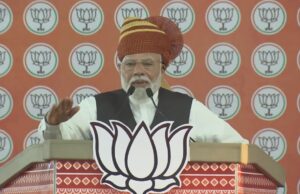In an attempt to grab the electorate’s attention, the Shiromani Akali Dal (SAD) unveiled its latest poll manifesto, which focuses on an important promise: the ownership of Kartarpur Sahib from Pakistan to India via a bilateral land swap. While the proposal evokes patriotic feelings, a deeper examination indicates that the true problems plaguing Punjab are within its boundaries, not across them.
Punjab, historically an epicenter of cultural and agricultural success, suffered a huge setback in 1966. The reorganization of states resulted in the emergence of Haryana and Himachal Pradesh, which carved off significant sections of Punjab land. This change decreased Punjab’s area from 202,000 square kilometers to a tiny portion of its previous size. The central Government’s decision to place Chandigarh, the former capital of Punjab, under its direct control intensified the state’s sense of loss and isolation. This territorial reduction was more than just geographical; it shattered a coherent Punjabi identity and scattered its people, depleting critical economic and agricultural resources. The previously fertile fields that fed the nation were split, leaving Punjab with inadequate resources to support its own people. These historical scars continue to feed the frustrations stated in the SAD manifesto.
Water Issues and Agriculture Crisis
The continuing water issue with Haryana has exacerbated the issues in Punjab. The state’s agriculture economy is dependent on the waters of the Ravi and Beas rivers. However, development of the Sutlej-Yamuna Link (SYL) Canal, which is planned to shift water to Haryana, has provoked severe opposition. Punjab maintains its historical and riparian rights to these rivers, believing that the canal will aggravate the state’s already severe water deficit, pushing it into an agricultural disaster. The SYL Canal signifies more than simply a water conflict; it illustrates a larger fight for resource management and Punjab’s view of being ignored by the Government. For the Sikh community, this is an existential issue that threatens to destroy their lands and livelihoods of the people in Punjab.
Kartarpur Sahib and Cross-border Dynamics
In contrast to these disputes within itself, the SAD emphasis on Kartarpur Sahib, a site of deep religious significance for Sikhs. The Kartarpur Corridor, a rare collaborative effort between India and Pakistan, enables Sikh pilgrims to visit the Gurdwara Darbar Sahib at Kartarpur without a visa. This effort is being praised as a beacon of a connection and kindness, representing Pakistan’s respect for the Sikh minority.
The extension of the Baba Guru Nanak Darbar shrine from 5 acres to 975 acres demonstrates Pakistan’s dedication to cultivating goodwill. This act of respect intends to deepen relationships between the two countries, anticipating a future in which boundaries become less important, comparable to the European model of open and cordial interactions. However, while the SAD’s proposal for a land swap with Pakistan is symbolic, it diverts attention away from Punjab’s serious domestic challenges.
Despite its lofty cross-border ambitions, the SAD manifesto fails to address major challenges in Punjab. The proposal for the handover of Kartarpur Sahib is symbolic, but it fails to address the root causes of territorial disintegration, insufficient resources, and economic imbalance. Punjab’s problems are largely rooted in its history of territory loses and continuous disputes over resources. These internal concerns, rather than external forces, are the source of the people’s frustrations and sense of marginalization. True progress for Punjab entails resolving these internal grievances—ensuring equitable resource allocation, preserving agricultural interests, and instilling a feeling of unity and identity in its people.
The manifesto of the Shiromani Akali Dal highlights the intricate interplay of political, cultural, and historical elements that have produced Punjab’s current situation. Even while the proposal to move Kartarpur Sahib from Pakistan is a potent representation of larger goals, the underlying problems necessitate reflection and internal change. Punjab’s future depends on resolving past wrongs, obtaining resources, and promoting internal harmony. Punjab can only attain full sovereignty and prosperity by confronting its internal issues. The state’s road is one of perseverance and a never-ending quest of justice.
Sara Nazir is an Islamabad-based researcher with a background in Strategic Studies & area of interest is non-traditional warfare. She can be reached on saranazeer2@gmail.com & @SaraNazir13 (on X).




